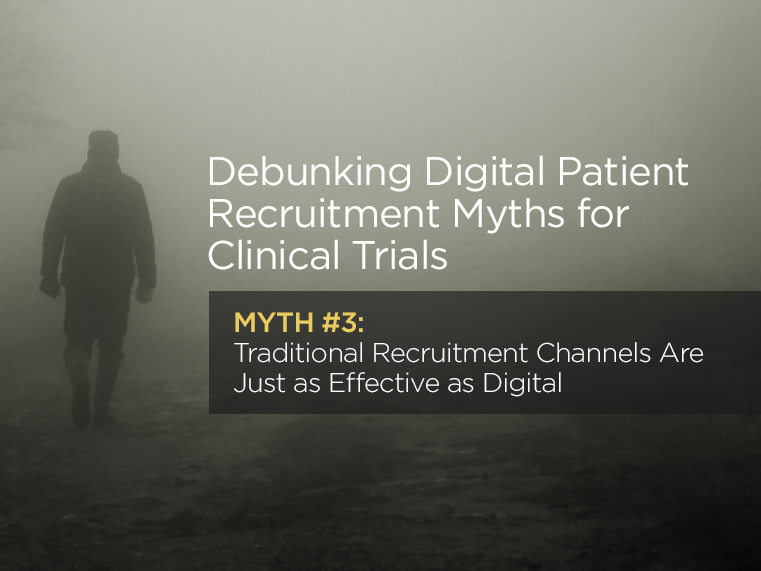
When it comes to clinical trial recruitment, fiction often rules the day. In this series, we debunk some of the most common misperceptions about digital recruitment for clinical trials, and set the record straight with hard facts and actionable solutions.

When it comes to clinical trial recruitment, fiction often rules the day. In this series, we debunk some of the most common misperceptions about digital recruitment for clinical trials, and set the record straight with hard facts and actionable solutions.
“Traditional recruitment channels are just as effective as digital.”
For many CROs and trial sponsors, traditional recruitment channels feel like the safest bet out there. After all, clinicians have used these channels to attract participants for decades — why would you want to risk trying something new when they can play it safe by sticking to the preordained game plan?
However, it’s becoming increasingly clear that these “tried-and-true’ methods are, in fact, the riskier options. Indeed, digital recruitment techniques are far more affordable, targetable, and optimizable than traditional media, which in turn makes them more impactful overall.
Reach Transactional Patients
For CROs and sponsors, one of the key benefits of digital is that you can reach highly specific patient demographics at “transactional” moments — i.e., when they’re actively seeking trial enrollment. According to MediciGlobal, patients engaged in this way are between 19-53% less likely drop out of clinical trials, according to Medici Global. Using proactive tactics like highly-targeted search engine marketing (SEM) campaigns, clinicians can get their message to patients the moment they type, “Treatment options for osteoporosis” into Google.
Comprehensive Tracking
Traditional channels like print, radio, TV, and mail give little feedback about patient engagement; are candidates actually reading and responding to your materials? It’s hard to tell. With a digital tracking system — which integrates with clinical systems — recruiters will receive clear and actionable data on specific media performance and efficacy.
At the same time, easy-to-navigate clinical websites and e-screening process dramatically improves the patient enrollment experience. This not only reduces the burden on applicants to answer repetitive survey questions and input their personal information over and over again (screening has been shown to have 100% accuracy, according to the NIH), it also gives sponsors a comprehensive downstream picture of overall recruitment performance.
Try Before You Buy Minimizes Lower Cost
Initial investment minimums in radio, TV, and print are typically high. Sponsors often end up spending between $30-$50K before they get clear feedback on their campaigns. With digital, you can start out low and test the waters; when you figure out what works and what doesn’t, it’s easy to ramp up your digital spend accordingly. In other words, you get to “try before you buy.” Of course, once you scale your campaign, you’re not stuck with it, Marketers optimize campaigns continuously, correcting any inefficient ad placements in real time.
Higher Return on Investment
Finally, is digital marketing not as financially effective as digital? The answer is no; with actively managed campaigns, we routinely see reductions between 20 and 40% over clinician’s previous marketing strategy (39-61% on cost-per-referral). The additional strength of digital is that you don’t simply receive a report on how your campaign performed after the trial has concluded — metrics are comprehensively tracked throughout every step of the process, enabling you to continually tweak and optimize your efforts over time.
Each digital tracking metric can be overlaid with financial information, giving clinicians a clear, up-to-date picture on everything from ROI to cost-per-referral (CPR), cost-per-enrollment (CPE), and cost-per-inquiry (CPI). Simply put, you’ll know that your strategy is effective, and you’ll know why.
While maximizing your success will likely require adopting a holistic approach, centering your recruitment efforts around a highly targeted, digital campaign will ultimately be the most effective way to go. Don’t simply rely on the “wait and see” method of traditional recruitment channels — seek out the tools and tactics that enable you to hone in on only those prospective participants who are actively seeking treatment options.
![]()








